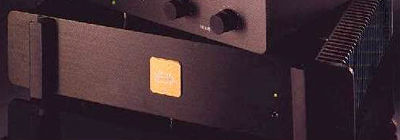| Columns Retired Columns & Blogs |
YBA 2 HC power amplifier
"My car is supercharged, not turbocharged, so you see there's no throttle lag," explained Yves-Bernard André as he reversed at what seemed like 80mph up a narrow cobbled Paris street. "D'accord," I mumbled, afraid to loosen the white-knuckled grip I had on the passenger grab handles. Yves-Bernard's car may have been pointing the right way down the one-way street, but it was not actually traveling in that direction. Okay, so it was 2am and the good residents of the Dix-septième Arrondissement were busy stacking Zs (en français, "emplier les ronflements"). But I still didn't think we would've been able to explain the logic of the situation to the gendarmes (les flics, en français).

Yves-Bernard André goes his own way in amplifier design too. He's a pillar of the French engineering establishment as a full-time electronics lecturer and researcher at l'Ecole Polytechnique, a technical university near his suburban Paris home. He also has strong ideas about how amplifiers should be designed. These ideas are embodied in the YBA products, which are distributed by his wife, Ariane's, company, Phlox Electronique. His basic ideas for power amplifiers are: short signal paths; a fully symmetrical, complementary circuit topology with as little global negative feedback as possible; as few series passive components as possible in the signal path (especially no output inductor); transformer cores aside, an absence of magnetic materials; meticulously selected parts; and careful attention paid to microphony and working temperature.
"Over-engineering!" snorts the traditional electronics community, whose collective mind is repelled by the idea of spending $5 for a worry-free, tight-tolerance premium resistor where a 5-cent carbon-film, sloppy-tolerance resistor might give some of the performance to some of the people some of the time. But such attention to detail, such concern to what less conscientious designers appear to regard as irrelevant components, seems as natural to Yves-Bernard as choosing to sip a properly aged, carefully decanted premier cru St. Emilion rather than chugging a gallon jug of Carlo Rossi. "Eh bien; how is that it could not be that way, mon ami?" Yves-Bernard asks as he slams his Volkswagen on opposite lock 'round the Porte Maillot exit off the Boulevard Périphérique, white tire-smoke heralding our entry into the mother of cities (Paris, en français).
YBA 2 HC
YBA amplifiers range from an $1850 integrated amp—L'Intégré—to the ultra-expensive Signature remote-controlled preamplifier and power amplifier. This middle model in YBA's range is available in two versions: the YBA 2 HC (high current) at $3750, reviewed here, and the basic YBA 2 at $3100. From what I could glean from the YBA literature, the difference is primarily the use of one mains transformer in the less expensive model, and two (one for each channel) in the high-current version.
The small but very heavy chassis is attractively finished in blue-gray anodized aluminum, with black heatsinks running the length of its sides. The front panel features two handles, an On/Off switch, and a red LED. The rear panel has a vertical pair of 4mm sockets at each end, with a gold-plated and Teflon-insulated RCA jack next to it. In the center, an IEC AC socket carries a 10A fuse.
The 2 HC's interior holds two C-core AC transformers mounted on Sorbothane washers just behind the front panel, and a printed circuit board with each channel's diode bridge, four 4700µF reservoir capacitors, and circuitry kept physically separate. Don't let the single pcb fool you: this is a true dual-mono amplifier.
The circuit for each channel is simple, with a direct, logical layout that minimizes pcb track length. The input is taken from the RCA jack on a short twisted-pair cable to the board, where DC is blocked with a capacitor. It then feeds the bases of two complementary long-tailed pairs of bipolar transistors, each with a constant-current emitter load. The inverting collector outputs are taken to a complementary pair of pre-driver transistors, these followed by hefty flat-pack driver transistors. The two complementary pairs of TO-3 output devices are mounted very close to the reservoir capacitors, which are bedded in at ±46.5V. Each power transistor sits on a 0.22 ohm emitter resistor, with the common points taken to the positive output socket via a 5A slow-blow fuse in parallel with a 10k resistor.
- Log in or register to post comments




































